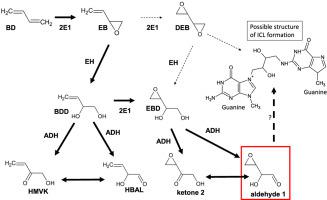Chemosphere ( IF 8.1 ) Pub Date : 2020-11-30 , DOI: 10.1016/j.chemosphere.2020.129149 Jun Nakamura , Sujey Carro , Avram Gold , Zhenfa Zhang

|
1,3-Butadiene (BD) is abundant in combustion products such as cigarette smoke. While BD has been classified as a known human carcinogen, a long-standing question is the identity of the ultimate carcinogenic metabolite in humans. We hypothesize that 3,4-epoxybutane-1,2-diol (EBD) may play a critical role in human carcinogenesis due to its high bioavailability. We utilized a differential toxicity assay for BD metabolites and newly synthesized EBD analogs in a series of isogenic chicken cells lacking specific DNA repair proteins to address the mode of action of BD genotoxicity and infer a mode of action. Surprisingly, as with the diepoxide 1,2:3,4-diepoxybutane (DEB), the monoepoxide EBD showed remarkable toxicity to cells deficient in Fanconi anemia (FANC) genes. This observation suggests that EBD may be transformed into a bifunctional metabolite and forms interstrand cross-links. EBD and its analog with a hydroxy substituent at C1 were found to be highly toxic to FANCD2-deficient chicken and human cells. The Results suggest that EBD may be transformed to a bifunctional epoxy aldehyde, perhaps by alcohol dehydrogenase, to which the observed FANC sensitivity could be attributed. The implications of this study are very important in considering mechanisms by which EBD may cause leukemia and lymphoma in humans exposed to BD.
中文翻译:

意外的丁二烯二醇环氧介导的遗传毒性暗示了1,3-丁二烯致癌性的替代机制
1,3-丁二烯(BD)在香烟等燃烧产物中含量很高。BD已被列为已知的人类致癌物,但长期存在的问题是人类最终致癌代谢物的身份。我们假设3,4-环氧丁烷-1,2-二醇(EBD)可能由于其高生物利用度而在人类致癌中起关键作用。我们对一系列缺乏特异性DNA修复蛋白的等基因鸡细胞中的BD代谢物和新合成的EBD类似物进行了差异毒性试验,以解决BD遗传毒性的作用方式并推断作用方式。令人惊讶的是,与二环氧1,2:3,4-二环氧丁烷(DEB)一样,单环氧EBD对缺乏Fanconi贫血的细胞(FANC)基因。该观察结果表明,EBD可转化为双功能代谢产物并形成链间交联。发现EBD及其在C1具有羟基取代基的类似物对缺乏FANCD2的鸡和人细胞具有高毒性。结果表明,EBD可能通过酒精脱氢酶转化为双功能环氧醛,这归因于观察到的FANC敏感性。这项研究的意义对于考虑EBD可能引起暴露于BD的人的白血病和淋巴瘤的机制非常重要。











































 京公网安备 11010802027423号
京公网安备 11010802027423号